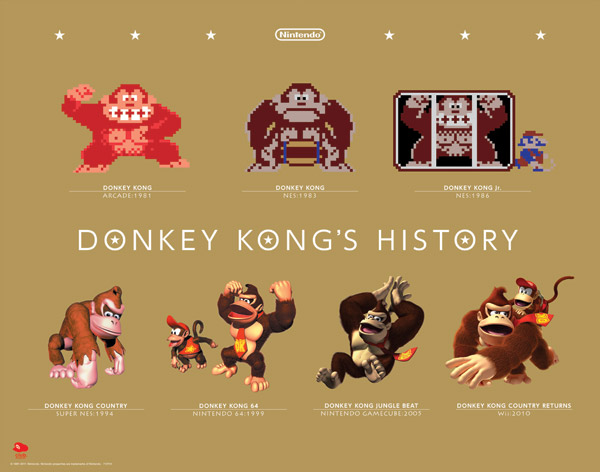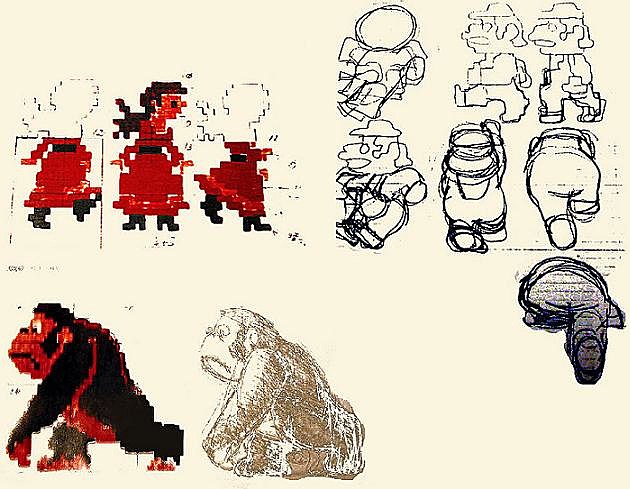Donkey Kong's Secret History: From Arcade Machines to NES
- Transfer

Donkey Kong is probably one of the greatest outsiders in the game world. He broke all the rules, because its creator, now legendary Shigeru Miyamoto, did not know these rules. It not only marked the beginning of one of the brightest minds of the video game industry, but also engendered the “run and jump” genre, making Nintendo one of the oldest pillars of the industry.
Thirty years later, Donkey Kong still remains one of the most recognizable characters, but much of its history has not yet been told. In most stories about his development, Miyamoto seems to be the only creator; his sketches, ideas and sprites seemed to come to life thanks to some kind of magic or modest workers who are not even worth mentioning. Over the years, the question of who developedDonkey Kong remained unanswered because it was rarely asked.
Before captions at the end became standard practice in video games, developers found other ways to sign their work, usually in high score tables, but sometimes with messages or initials in the ROM itself. Sometimes these were the only clues that allowed us to link games with their authors.
When studying the Donkey Kong ROM, you can find a fairly detailed message:
CONGRATULATION! IF YOU ANALYSE DIFFICULT THIS PROGRAM, WE WOULD TEACH YOU. ***** TEL.TOKYO-JAPAN 044 (244) 2151 EXTENTION 304 SYSTEM DESIGN IKEGAMI CO. LIM.
(CONGRATULATION! IF IT IS DIFFICULT TO ANALYZE THIS PROGRAM, WE WILL TEACH YOU. ***** TOKYO-JAPAN TEL. 044 (244) 2151 ADDITIONAL 304 DEVELOPMENT OF IKEGAMI CO. LIM.)
Ikegami Co. Ltd., also known as Ikegami Tsushinki, is an engineering firm still operating today. It is rarely associated with the development of video games. But in the late 1970s and early 1980s, she was one of the “shadow developers” of the Japanese market - contractors like the famous TOSE , who developed the games secretly, without any indication in the credits.
This secret message can be found not only in Donkey Kong , but also in other classic games of the 1980s, such as Zaxxon and Congo Bongo , released under the Sega brand. Ikegami was not just a group of hired coders; it was a complete development team, capable of repeating success, and unlike other shadow developers, it owned the rights to the games it created, which is whyDonkey Kong was at the center of a serious copyright conflict.
Good luck novice
Shigeru Miyamoto joined Nintendo, the fast-growing toy manufacturer in 1977. It seemed like a dream job for an artist / engineer who just graduated from college. He joined the company in the hope of making toys. But Nintendo was just beginning to explore the new environment, the emerging market of coin-operated video game machines, and the realization of Miyamoto’s dream had to be postponed. Nintendo President Hiroshi Yamauchi instructed the young designer to create a shell and promotional materials for the new video games: Sheriff, Space Firebird and Radar Scope .

Unlike previous arcade machines from Nintendo - mostly electromechanical entertainment - these machines were programmable video games with fairly modern equipment, a serious step towards competition with manufacturers such as Taito, which changed the world of arcade games with the release of Space Invaders .
The Nintendo executives knew what was needed for competition, but the modest engineering department of the company had not yet become a video game development studio. Nintendo turned to Ikegami Tsushinki, who agreed to create games under the Nintendo brand, as well as develop and produce equipment on which they will run. Nintendo was supposed to produce their own corps and do all marketing. The deal seemed fair.
Thanks to the attractive design of the machine, or to the clever gameplay, Sheriff and Radar Scope were successful in Japan, but such rivals of Nintendo, Taito and Namco, conquered the American market, and Nintendo also wanted to take part in it. Yamauchi instructed his adopted son Minoru Arakawa to set up an office in America, and their primary business objective was to bring the Radar Scope to the US market.
Since Nintendo could not create enough of its own equipment Radar Scope, she was forced to pre-order machines from Ikegami. Expecting that America would take the game with the same warmth as its native Japan, Nintendo ordered Ikegami three thousand machines and transported them to the American warehouse for products in Washington.
Alas, Radar Scope did not hit in America. It was possible to sell only a thousand devices, and two thousand arcade machines with very expensive equipment remained to lie in the warehouse of Nintendo. The consequences could potentially become devastating. Nintendo could either surrender, accept a financial collapse, or develop a conversion kit that could turn these machines into the right market. Arakawa begged his stepfather to choose the second option.
Nintendo lacked experienced game developers, so Miyamoto was appointed to lead the project. Miyamoto did not create a single game before, but he did sketches of the characters while he was still working on the Nintendo machines. Yamauchi assured him that lack of technical skills would not be a problem. Miyamoto will simply give instructions to the Ikegami Tsushinki team, and she will develop the game according to his ideas. Gumpay Yokoi, later known as the father of the Game Boy, was supposed to help Miyamoto with technology and design.
It was not only the first real game design created by Miyamoto, but also the first time that anyone from Nintendo was deeply involved in the game development process. Assignment to an inexperienced designer of such an important project may seem like a risky move, but it will soon become clear that Miyamoto’s huge resource is his unique outlook on things. Miyamoto did not fit the design of games like the rest. At a time when most games borrowed plots from action films — shootouts, races, submarines, and intergalactic battles — Miyamoto wanted his game to look more like a revived comic.
Even the concept of different characters with their own personality was rather unusual for the arcade games of those years, but for the vision of Miyamoto, the characters and the plot were fundamental.
Initially, he hoped to create a game based on the comic "Popeye" and his eternal battle with Bluto for "the girl in need " Olive Oil. Nintendo could not get a license (at least at that moment), so the designer replaced the classic love triangle with the theme of King Kong.
Distraught from love, the gorilla climbed to the top of the scaffolding with a beautiful girl, and her boyfriend carpenter should come to her aid. Only one picture of the script can tell the whole story in a noisy and lively hall of arcade machines.
Even the ways in which Miyamoto's vision was conveyed resembled the comics that inspired him. Like the designer of Sonic the HedgehogHirokazu Yasuhara, he painted scripts on paper. Each of them was a bizarre sketch of how the game should have been felt. Although the jumps were not new mechanics in games, Miyamoto saw the character jumping over obstacles, on mobile platforms and across abysses like no one had done before. The gameplay was just exciting, fun, and fully reflected the frivolous mood of the game.

A concept art game drawn by Shigeru Miyamoto.
Created by two companies, the game could say a lot without speaking a word. The decision to show a huge monkey, crushing scaffolding, Pauline, calling for help and escape of the gorilla at the end of the level, was at that time very bold. Usually, these things were only implied, but Miyamoto wanted the whole story, however simple, to be told on the screen and instantly clear to the players.
It also made it possible to create an innovative, multi-stage design that can boast four different screens with unique difficulties, while not confusing the players. Pauline was always at the top of the screen and begged for help, and Mario’s goal was clear. The desire to see new levels, rather than just repeating one again and again, will motivate players, especially the most casual ones, to throw more and more quarters into the machine. This could not be achieved if the only task left to hit the table of records.

Yamauchi immediately realized that Miyamoto’s game could save Nintendo’s sinking business in America. He asked the designer to give the game an English name that would be understandable to the Americans. Of course, Miyamoto knew very little English, so he tried to find a word that accurately conveys the stubbornness of the monkey, and as a result came up with a rather confusing " Donkey Kong " ("Donkey-Kong").
But that didn't matter. The game appeared just in time to save the American branch of Nintendo. The situation was so desperate that the landlord of the company, Mario Segale, came to demand late rent debts. Arakawa thought that the mustache was a bit like the hero of the game, Miyamoto, so Jumpman was renamed Mario after him.
Battle for rights
While Donkey Kong was preparing to release, the American branch of arcade machines Nintendo hung in the balance. There were such difficulties with resources that three Nintendo of America employees had to independently convert two thousand Radar Scope machines into Donkey Kong . But as soon as the devices began to make their way into the dark halls of arcade machines across the country, the only problem Nintendo was having to get new ones.

Automatic Radar Scope, converted to Donkey Kong
But the task was not as simple as it seemed. Ikegami Tsushinki created the initial batch of cards, just like for the Radar Scope , but Donkey Kong turned out to be a huge hit, and Nintendo needed more. The demand in America was so great that Arakawa began to produce new machines at the Nintendo of America warehouse.
But in fact, Nintendo did not own the rights of production Donkey Kong. Although her game remained a product of Nintendo, and the characters, name and brand belonged to her, Ikegami Tsushinki gave the development contract exclusive rights to manufacture and sell Nintendo boards for 70,000 yen each. After the first order of 8,000 devices, Nintendo stopped buying motherboards from Ikegami. Although the contract did not clearly indicate the owners of the rights to copy the program code (for legislation it was a new area), Ikegami was called in it the only supplier of Donkey Kong boards .
But Nintendo saw the situation differently. In a short time, Nintendo produced about 80,000 new devices without Ikegami, and thus burned the bridges with the company that created its biggest hit. This opened for a serious legal battle that will last almost a decade.
In addition, Nintendo lost its development team, which could build on the success of its hit. Nintendo wanted a sequel, but for Ikegami everything was over. Shortly thereafter, Ikegami will begin the anonymous development of innovative high-profile hits Zaxxon and Congo Bongo for Sega, contributing to the development of one of Nintendo’s biggest rivals. Obviously, Ikegami Tsushinki was an unusually talented team, but its conditions were too strict for the needs of Nintendo, so it needed to find a new partner.
Nintendo hired another contractor called Iwasaki Engineering for disassembling and reverse engineering Donkey Kongso that Nintendo can add new graphics, levels and mechanics to the sequel. This time the terms of the agreement were clear to both parties from the very beginning, and it was the beginning of a long and fruitful cooperation. When Nintendo opened an internal research and development department, many Iwasaki employees joined its ranks. Soon, Nintendo began to develop hit games on its own.
Shigeru Miyamoto continued to have new ideas in his head before he completed the first Donkey Kong , so the appearance of the sequel was completely natural. He wanted to show that the title antagonist was not just a big evil monkey, so he decided to show the story from the point of view of Kong.
Of course, DK was too huge to become a player’s character, so Miyamoto made him his father by adding a new hero, Junior, who was supposed to save his father from the vengeful Mario.
In place of the stairs came creepers and chains, and the developers replaced the barrels with predatory Snapjaw and birds. For the sequel, released so quickly after the original, Donkey Kong Jr. turned out to be a quality sequel, and the patterns of his gameplay did not resemble the predecessor.
The large number of mobile sprites was overwhelming for 1982, and crawling and grabbing mechanics were fresh. Unique levels again supported the variability of gameplay, forcing players to throw a quarter by quarter in the hope of going a little further.
But despite all their very original ideas,Donkey Kong Jr. it was still based on the reverse development of the original game code — a code that was at the center of copyright disputes. In 1983, Ikegami Tsushinki filed a claim for 580 million yen (approximately $ 8.7 million, taking into account the exchange rate and inflation) about copyright infringement and Donkey Kong and his sequel.
Legal battles lasted for years, long after Ikegami went out of the game development business. In 1990, a court ruled that Nintendo had no rights to the Donkey Kong code., and the two companies settled their claims in court for an unnamed amount. The case was closed, and Ikegami had long gone out of the gaming business, and after that very few people spoke about Miyamoto's anonymous assistants and the role they played in creating one of the most important projects of the game world.
The emergence of the empire

The litigation surrounding the development of the first international hits of Nintendo remained almost imperceptible against the background of the enormous influence exerted by the game itself. Donkey Kong and his sequel essentially engendered a new sideways jumping genre, giving rise to countless imitators (some of them were talented and others terrible), which began to appear in America, Japan and Europe on arcade machines, consoles and home computers. By 1983, in the West, this genre began to be called "platform games."
In 1982, Shigeru Miyamoto managed to create his own Pop I game with an official license and a completely new, powerful equipment. Nintendo has begun the development of the third game of the Donkey Kong series with a completely new main character Stanley the Exterminator.
The third part of the trilogy was little reminiscent of its predecessors, it abandoned platform mechanics in favor of unusual mock motifs: Stanley tried to drive DK into a beehive with an insect spray. She failed to achieve the same popularity as the previous games, and Donkey Kong was permanently put on the shelf.
By creating an internal development team and a small set of strong brands, Nintendo was ready for the most ambitious step. In 1983, Nintendo released a completely new Famicom console with three ports of Sigeru Miyamoto arcade games: Donkey Kong , Donkey Kong Jr. and popeye .
Although due to the size of the ROM and the screen resolution, it was necessary to make concessions, the ports were much closer to the actual arcade gameplay than any other home system of the time. It paved the way for Nintendo's long dominance in the console market. By the time NES reached the shores of America, Nintendo had already turned off the development of arcade machines. In just a few short years, Nintendo has changed the face of the gaming market.
Donkey Kong is still one of the most recognizable Nintendo characters, although in its current form, players from 1981 would hardly have recognized him. But the legacy of Kong was much more extensive. If you can't imagine a world without Super Mario Brothers , without NES, and possibly without Nintendo, then you can't imagine a world without Donkey Kong. At the same time becoming a remarkable masterpiece of game design and a commercial breakthrough for one of the most important gaming companies in Japan, Donkey Kong changed the world, and after almost 40 years we still feel its influence.
